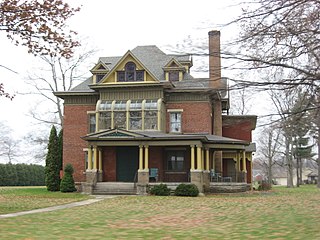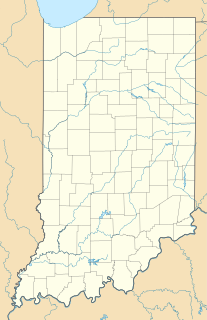
Independence Historic District, also known as the West Franklin Street-Wabash Avenue Historic District, is a national historic district located in the Lamasco neighborhood of Evansville, Indiana. The district developed after 1880, and encompasses 95 contributing buildings and 1 contributing site. It includes commercial and residential properties and representative examples of Italianate, Queen Anne, Romanesque, and Beaux-Arts style architecture. Notable buildings include the West Branch Carnegie Library (1912), Laval Block, Heldt-Voelker Hardware Store (1890), First Federal Savings, Gerke Building, August Rosenberger House (1894), and St. Boniface Church.

The Delphi Courthouse Square Historic District in Delphi, Indiana is a 23-acre (9.3 ha) area roughly bounded by Monroe, Main, Market and Indiana Streets. It was listed on the National Register of Historic Places in 2010. It includes Italianate architecture and Classical Revival architecture and work by Elmer Dunlap among its 31 contributing buildings.

Upper Main Street Historic District is a national historic district located at Lafayette, Tippecanoe County, Indiana. Sixth Street was the City of Lafayette's eastern boundary when it was originally platted. By 1840, the boundary was extended to include Lake Erie and Wabash Railroad at Eleventh Street. This area became the cities commercial center. Businesses around Eleventh Street developed to meet the traveling publics needs. The Enterprise Hotel, at 1015 Main Street, as well as the Alt Heidelberg, American Lafayette and the Derby Hotel were early established by 1899.

South Walnut Street Historic District is a national historic district located at Edinburgh, Johnson County, Indiana. The district encompasses 41 contributing buildings in a predominantly residential section of Edinburgh. It developed between about 1850 and 1935, and includes notable examples of Greek Revival, Italianate, Queen Anne, Romanesque Revival, and Bungalow / American Craftsman style architecture. The dwellings include tiny works' cottages, modest middle-class homes, and large expensive homes of the wealthy. Notable buildings include the First Christian Church and the Methodist Church.

Haven Hubbard Home, also known as Hamilton Grove, is a historic sanitarium and national historic district located in Olive Township, St. Joseph County, Indiana. The district encompasses six contributing buildings and one contributing site on a former sanitarium originally developed as a working farm. It was developed between about 1860 and 1961, and includes examples of Second Empire, Queen Anne, Colonial Revival, and Collegiate Gothic architecture. Notable buildings include the Hubbard Homestead Home, Homestead Shed, Homestead Barn, Pump House, Epp Hall, and Haven Hubbard Home Parsonage (1960).

Ellsworth Historic District, also known as Ellsworth Addition, is a national historic district located at Lafayette, Tippecanoe County, Indiana. The district encompasses 144 contributing buildings, 1 contributing site, and 4 contributing structures in a predominantly residential section of Lafayette. It developed between about 1844 and 1936 and includes representative examples of Italianate, Second Empire, Queen Anne, and Bungalow / American Craftsman style architecture. Located in the district are the separately listed Falley Home, Moses Fowler House, and Temple Israel. Other notable buildings include the Second Presbyterian Church (1894-1895), Alexander House, Ball Brothers House, Falley Townhouse, Home Block, Annie Fowler House, and Duplex Townhouse.

Jefferson Historic District is a national historic district located at Lafayette, Tippecanoe County, Indiana. The district encompasses 161 contributing buildings, 2 contributing sites, and 22 contributing structures in a predominantly residential section of Lafayette. It developed between about 1853 and 1951 and includes representative examples of Italianate, Greek Revival, and Bungalow / American Craftsman style architecture. Notable contributing resources include the Deutsche Evangelische Kirche (1905), Isador Metzger House, Hubert Gilmartin House, B.F. Biggs Pump Factory Building, Deutsche Methodist Kirche (1885), Herman & Mary Fletemeyer House, Mohr House, Warrenberg-Reule Double House, Alfred Gaddis House, Wabash Valley House (1862), Haywood Tag Company Building (1928), and Jefferson High School (1927).

Ninth Street Hill Neighborhood Historic District is a national historic district located at Lafayette, Tippecanoe County, Indiana. The district encompasses 88 contributing buildings and 6 contributing structures in a predominantly residential section of Lafayette. It developed between about 1850 and 1946 and includes representative examples of Gothic Revival, Italianate, Queen Anne, Greek Revival, and Second Empire style architecture. Located in the district is the separately listed Judge Cyrus Ball House. Other notable contributing resources include the Samuel Moore House (1891), Moore-Porter-Boswell House (1895), Stanley Coulter House (1890), Edward Bohrer House (1909), Thomas Wood House, Job M. Nash House (1859), and Gordon Graham House.

Perrin Historic District is a national historic district located at Lafayette, Tippecanoe County, Indiana. The district encompasses 173 contributing buildings and 2 contributing structures in a predominantly residential section of Lafayette. It developed between about 1869 and 1923 and includes representative examples of Italianate, Queen Anne, Colonial Revival, Stick Style / Eastlake Movement, and Bungalow / American Craftsman style architecture. Notable contributing buildings include the James Perrin House, John Heinmiller House, James H. Cable House, Adam Herzog House (1878), Coleman-Gude House (1875), Frank Bernhardt House (1873), August Fisher Cottage, John Beck House (1887), an William H. Sarles Bungalow (1923).

Indiana State Soldiers Home Historic District is a historic Soldiers Home and national historic district located in Tippecanoe Township and Wabash Township, Tippecanoe County, Indiana. The district encompasses four contributing buildings on the campus of the former Soldiers Home. They are the Post Exchange, Commandant's House, Library Building, and the Administration Building. Funding for the home was approved by the Indiana State Legislature in 1888, and building commenced in 1890. Most of the original buildings were demolished in the 1950s. The property continued to be administered by the Indiana Department of Veterans' Affairs as the Indiana Veterans’ Home

Wabash Avenue–West Historic District is a national historic district located at Terre Haute, Vigo County, Indiana. It encompasses 24 contributing buildings in the central business district of Terre Haute. It developed after 1870 and includes representative examples of Italianate, Romanesque Revival, and Renaissance Revival style architecture. Notable buildings include 408 Wabash Avenue, 425-431 Wabash Avenue (1867-1868), the White Block (1899), The Albrecht Building (1893), 522 Wabash Avenue (1890), 524 Wabash Avenue, Koopman Building (1875), Blumberg Building (1915), and the Hotel Deming (1914).

Wabash Avenue–East Historic District is a national historic district located at Terre Haute, Vigo County, Indiana. It encompasses 20 contributing buildings in the central business district of Terre Haute. It developed between about 1880 and 1940 and includes representative examples of Italianate, Romanesque Revival, Renaissance Revival, and Art Deco style architecture. Located in the district is the separately listed Indiana Theatre. Other notable buildings include The Kaufman Block (1863-1868), Terre Haute Trust Company (1908), the Tribune Building (1912), Bement-Rea Warehouse (1908), Swope Block (1901), AT&T Building, and Ohio Building (1912).

The James M. Amoss Building is a historic commercial building located at 110 Wabash Street in Wabash, Wabash County, Indiana.

North Wabash Historic District is a national historic district located at Wabash, Wabash County, Indiana. It encompasses 159 contributing buildings in a predominantly residential section of Wabash. It developed between about 1846 and 1949, and includes representative examples of Italianate, Queen Anne, Colonial Revival, and Bungalow / American Craftsman style architecture. Located in the district is the separately listed McNamee-Ford House. Other notable buildings include the John Wilson House, Milliner House (1890), Thomas McNamee House, Williams House, Eagle House, and David Kunse House (1846).

West Wabash Historic District is a national historic district located at Wabash, Wabash County, Indiana. It encompasses 283 contributing buildings in a predominantly residential section of Wabash. It developed between about 1840 and 1930, and includes representative examples of Federal, Italianate, Romanesque Revival, and Colonial Revival style architecture. Located in the district is the separately listed First Christian Church. Other notable buildings include the Jackson Family House, John and Lucinda Sivey House, Thomas and Hannah Whiteside House (1881), Matlock-Barnhart House (1866–1867), Alexander and Millicent Hill House, David and Sadie Cohen House (1909), Bennett E. Davis House (1842), Presbyterian Church (1881), Wabash Carnegie Public Library, and Wabash High School.

Downtown Wabash Historic District, also known as the Wabash Marketplace District, is a national historic district located at Wabash, Wabash County, Indiana. It encompasses 27 contributing buildings in the central business district of Wabash. It developed between about 1840 and 1920, and includes representative examples of Italianate, Romanesque Revival, and Second Empire style architecture. Located in the district are the separately listed James M. Amoss Building and Solomon Wilson Building. Other notable buildings include the E.M. Conner Building (1897), Back Saddlery and Harness Shop (1845), Wabash Loan and Trust Company (1927), Bradley Block (1901), Busick Block (1882), Eagles Building (1906), the Plain Dealer Building (1897), S.J. Payne Block (1898), J.C. Penney's (1920), National Block (1876), Sheriff's House and Jail (1879), Memorial Hall (1899), U.S. Post Office (1911-1912), Wabash County Courthouse (1878), Shively Block (1897), and Wabash City Hall (1883-1884).

North Manchester Historic District is a national historic district located at North Manchester, Wabash County, Indiana. It encompasses 159 contributing buildings in the central business district and surrounding residential sections of North Manchester. It developed between about 1870 and 1938, and includes representative examples of Greek Revival, Gothic Revival, Italianate, Queen Anne, and Bungalow / American Craftsman style architecture. Located in the district are the separately listed Lentz House, Noftzger-Adams House, and North Manchester Public Library. Other notable buildings include the John Lavey House (1874), Horace Winton House, Agricultural Block (1886), Moose Lodge (1886), North Manchester City Hall, Masonic Hall (1907), Zion Lutheran Church (1882), and North Manchester Post Office (1935).

LaFontaine Historic District is a national historic district located at La Fontaine, Wabash County, Indiana. It encompasses 56 contributing buildings and 4 contributing structures in the central business district and surrounding residential sections of La Fontaine. It developed between about 1848 and 1930, and includes representative examples of Gothic Revival, Italianate, Queen Anne, Romanesque Revival, Classical Revival, and Bungalow / American Craftsman style architecture.

Roann Historic District is a national historic district located at Roann and Paw Paw Township, Wabash County, Indiana. It encompasses 117 contributing buildings, 2 contributing sites, and 1 contributing structure in the central business district and surrounding residential sections of Roann. It developed between about 1853 and 1961, and includes representative examples of Gothic Revival, Italianate, Queen Anne, Second Empire, Colonial Revival, and Streamline Moderne style architecture. Located in the district are the separately listed Roann Covered Bridge, Roann-Paw Paw Township Public Library, and Thomas J. Lewis House. Other notable buildings include the First Brethren Church (1891), Dersham House and Veterinary Clinic, Roann Christian Church (1961), Watson House, Universalist Church (1875), Roann Methodist Church (1898), Paw Paw Township School (1941), James Van Buskirk House, Halderman Building, U.S. Post Office and Medical Building (1958), Nicely Oil Service Station (1938), Comer Building (1920), and Spiece House.

Halderman–Van Buskirk Farmstead is a historic farm and national historic district located in Paw Paw Township, Wabash County, Indiana. It encompasses five contributing buildings, one contributing site, and four contributing structure on a farm established in 1860. The farmhouse was built between 1860 and 1865, and is a 1 1/2-story, Gothic Revival style brick dwelling on a fieldstone foundation. Other contributing resources are the milk house, carriage house, dairy barn, livestock barn, corn crib, grain bin, cistern, and grain silo (1941).
























